All you need to know about your products!

| 3DNews Vendor Reference English Resource - All you need to know about your products! |
||||||
 |
||||||
|
|
||||||
Dual-core Intel Conroe processorsAuthor:Date: 15/08/2006 IntroductionThree years ago, AMD released a line of processors with the new A64 architecture and immediately won a technology advantage. Athlon64 processors ran at much lower clock speeds than Intel Pentium4 but demonstrated high higher performance. That was especially seen in gaming applications, i.e. in the field which is most common for home-based users. The advantage in speed was won due to the shorter pipeline as well as the integrated memory controller. Intel was struggling to the very best of its power continuously raising the clock speeds of it processors. But ... stopped the race having finally not achieved the 4 GHz threshold. Further rise in the clock speeds was simply impossible: the heat emission went beyond all the reasonable boundaries. To be fair, we should note that Intel's latest processors produced following the 65 nm process technology smoothed the problem of power consumption a bit. But Intel failed to grab the performance crown. Therefore, AMD was gradually expanding its market share, and in mere three years it overcame the ~25% barrier. In fact, that is the maximum possible market share for AMD because of the lack of production capacities. Of course, Intel was strongly against this situation. And some time ago there appeared first rumors on the forthcoming new processor architecture. There also appeared first specimens - I mean mobile CPUs Pentium-M on the Dothan core. Manufactured following the 90-nm process technology and running at ~ 2.5 GHz clock speeds, these processors showed a very high operating speed comparable to to that of top-end desktop AMD and Intel processors. Pentium-M proved so highly attractive that some companies prepared matching solutions for desktop systems. A bit later though, there appeared first information on processors built on the Intel Core 2 Duo architecture, which made the interest to Pentium-M gradually fade. Roughly speaking, the Core 2 Duo architecture is a logical evolution of the Pentium Pro architecture with the use of all Intel's technologies and developments. In particular, the new processors offer a rather short pipeline (14 stages) and are able decoding and executing up to instructions per cycle. For more detail of the Core 2 Duo architecture, read our previous materials. Today, we are focusing on the practical aspects of operating the new processors. In August 2006 onwards, the following models start appearing in the retail:
* - Core 2 Duo E4300 will appear in the retail even in Q'1 of 2007. Therefore, Intel has presented two cores of the Core 2 Duo architecture. These are Conroe and Allendale which differ in only the L2 cache size: 4 MB and 2 MB, respectively. Of note is that the L2 cache is shared, i.e each core is able fetching data from the whole cache size. We also mention the processor core Millvile which will have only one core. It is quite probable that value-sector processors will be released on its based (I presume that will no happen earlier than 2007). Visually, processors built on the Conroe and Allendale cores do not differ much from other LGA775 processors. In particular, the front side is hidden by a heat-spreader and fully coincides with other processors except the marking.  Just guess which of these is Conroe On the reverse side, we can see some slight changes in the positioning of capacitors. The CPU-Z utility displays the following information: 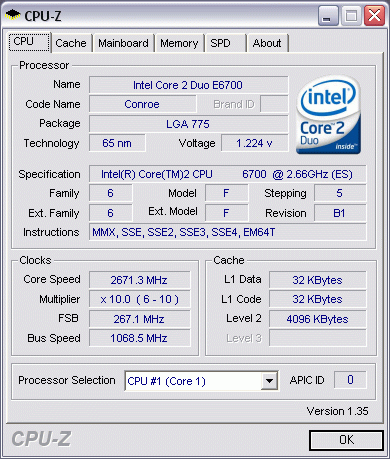 Just note the CPU stepping: The test specimen is of stepping B1. In fact, all the engineering samples and rare processors of the very first batches have had steppings B0 and B1. But all the processors to be sent to the official sales have stepping B2. Now let's look into other issues. Which of the listed processors should we buy? The answer is simple - the one you have enough money for. Another important question - which motherboard to choose? At that, there are more fine points. First, we should keep it in mind that the vast majority of LGA775 motherboards are incompatible to Core 2 Duo processors. The thing is, to support Intel's latest processors the power supply module of the motherboard should conform to the VRM 11 specifications. There are few of such motherboards: a couple of motherboards on the base of i975P (Intel D975XBX Bad Axe) and ASUS P5W-DH Deluxe), as well as a few boards on the P965 chipset. Once the P965 has been released, the number of motherboards on its base will be increasing (and they will all be compatible to the Core 2 Duo). It now makes sense to think which processor to take with overclocking kept in mind. Clearly, you should buy the cheapest, i.e. Core 2 Duo E6300 built on the Allendale core. It is also important to note that although the L2 cache size in Allendale is twice as small as in the Conroe core, the performance difference at a similar clock speed is within 2% (in some applications - up to 5-6%). Therefore, you don't have to worry about the small cache. But what you really have to take care of seriously is the multiplier which is = 7 in the model E6300. That means, to achieve the technology limit 3.5 GHz (provided there is air-driven cooling), we should increase the FSB speed to 500 MHz. That is a really impressive speed: for example, the FSB limit for Asus P5W-DH Deluxe is 450 MHz. Besides, for a stable operation at such frequencies there must be a feature for raising voltage on the chipset's north bridge. Therefore, the selection of a Core 2 Duo motherboard has to be effected really thoroughly. Quite possibly, it's better to spend a bit more to but a more expensive CPU with greater multiplier. In other words, we add 40$ and buy E6400 with the multiplier 8. As a result, to reach 3.5 GHz we should raise the FSB to 437 MHz, which is quite feasible! Therefore, potentially it is just the E6400 model that will be the overclocker's choice until the end of 2006. To be more precise, until the release of E4300 which runs at 1.8 GHz with the system bus speed 800 MHz (QPB). It's easy to calculate that the multiplier of the CPU is set to 9, which substantially facilitates overclocking. Again, this model will be the cheapest of all the Core 2 Duo processors. Once we are talking about the overclocking issues, let's conduct a small research "Overclocking and heat emission on the Conroe core". Overclocking and heat emissionWe note straight that Conroe and Allendale processors running in the nominal mode have a very low, to modern standards, heat emission. In particular, the lower CPU E6300 at 1.86 GHz has a typical heat emission = 65 W. Of major part in that is the very thin (65 nm) process technology as well as the relatively low supply voltage. With the Enhanced Intel SpeedStep enabled, the heat emission drops to 22 W. At the same time, the multiplier drops to 6, and the Vcore voltage reduces. Other processors also support this technology which allows reducing the multiplier to 6. So, for most users a boxed cooler would suffice. By the way, the new Conroe core contains 291 mln transistors, with its area being 144 sq.mm. As regards overclocking using air-driven cooling, then with the Gigabyte G-Power cooler we were able to attain 3.46 GHz clock speed with a minor rise of the Vcore. At the same time, the CPU temperature even when both cores are fully loaded, did not exceed 54° >
PerformanceWe tested the CPU at both nominal 2.66 GHz and at 3.46 GHz. Softly speaking, the results were pleasantly astounding. We used the following components:
We used a customary set of application benchmarks. Let's first take a look at the results of synthetic benchmarks. 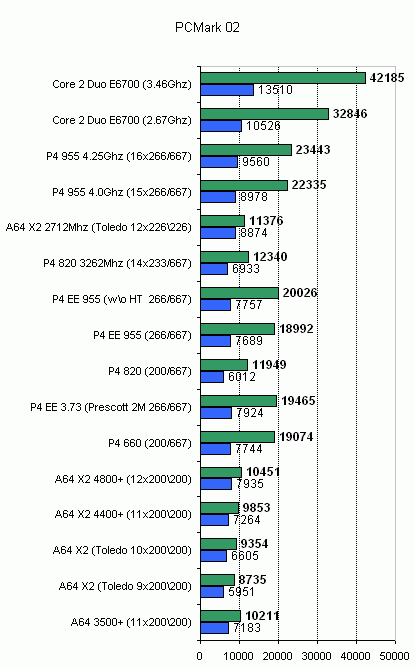 These are exclusively synthetic benchmarks which demonstrate the theoretical performance. Now on to the gaming benchmarks. 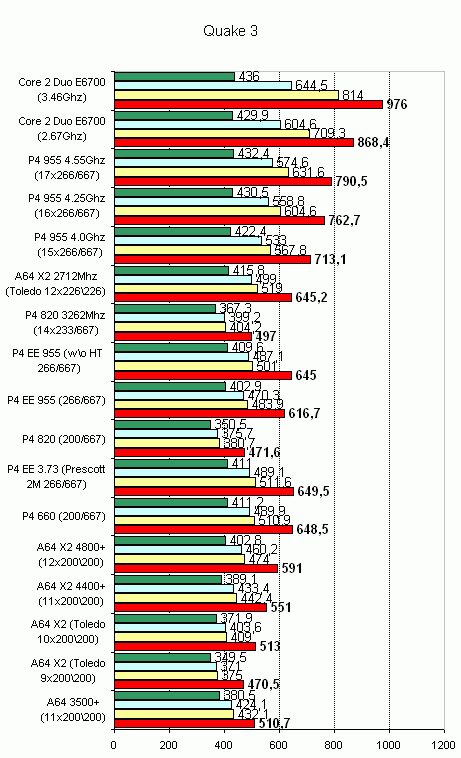 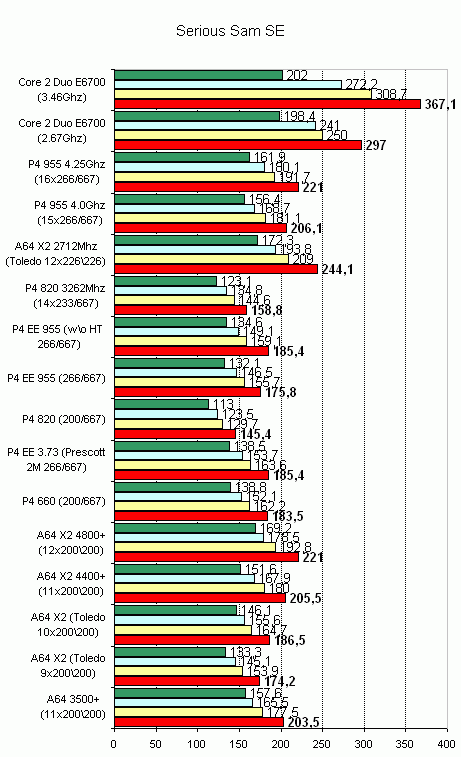 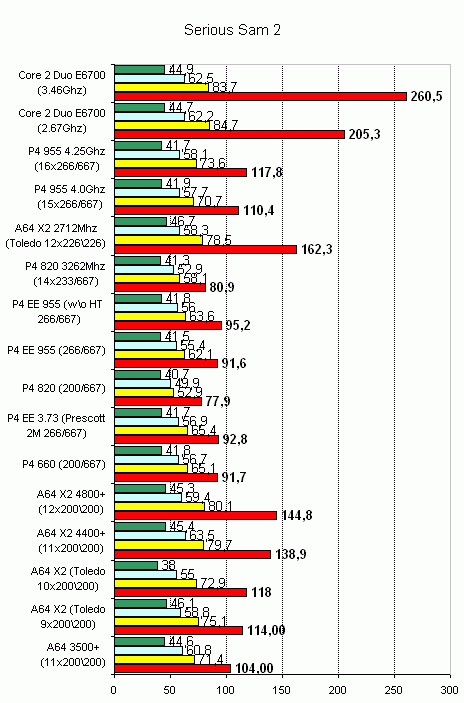 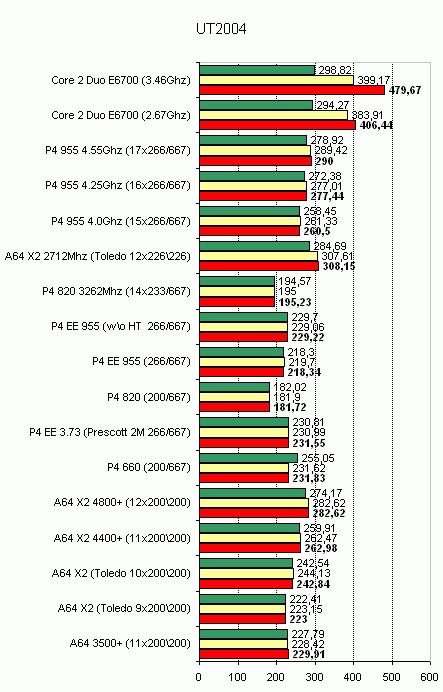 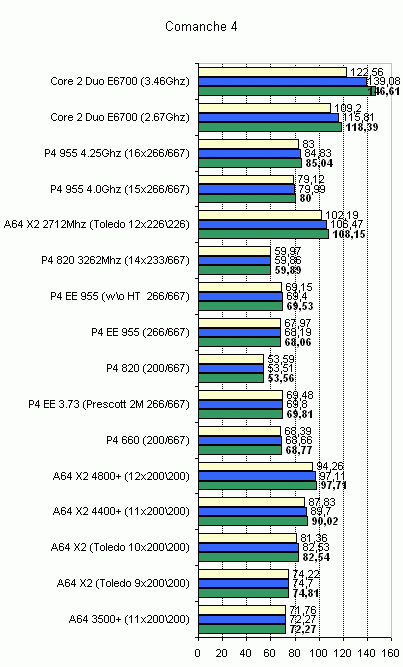 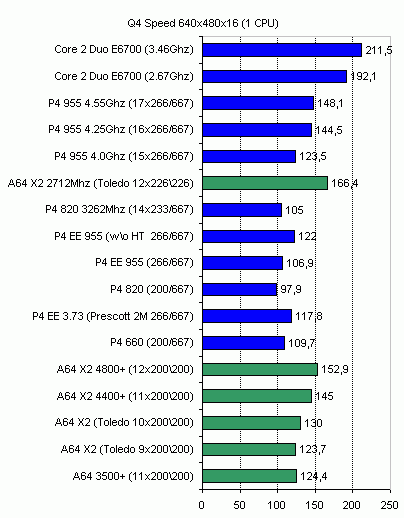 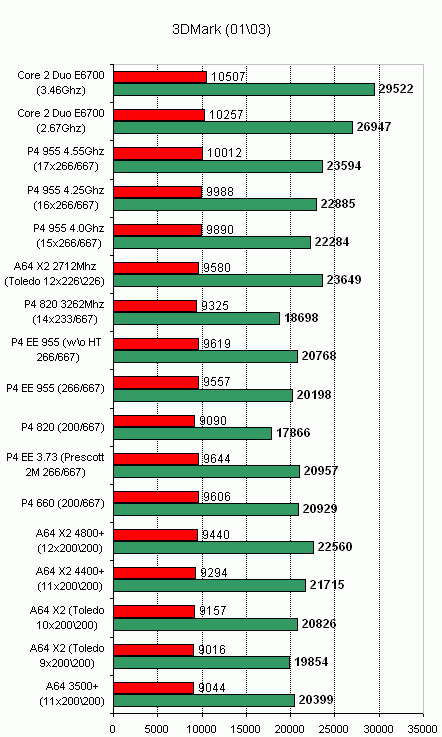 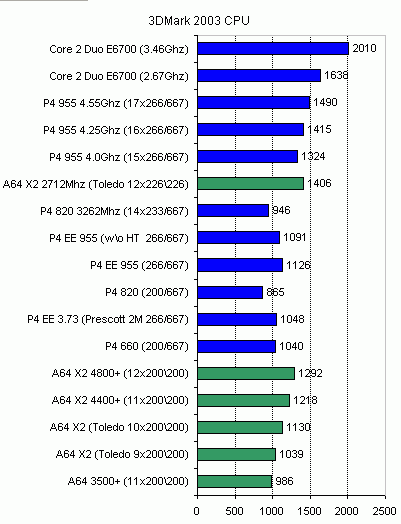 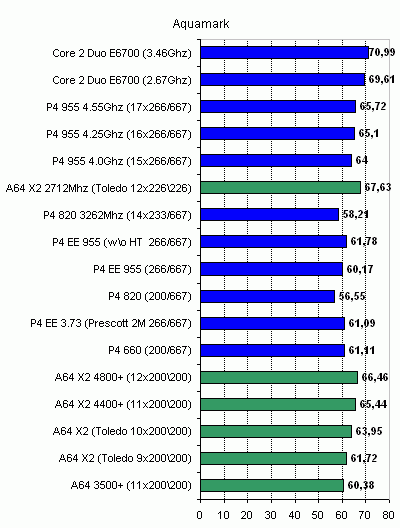 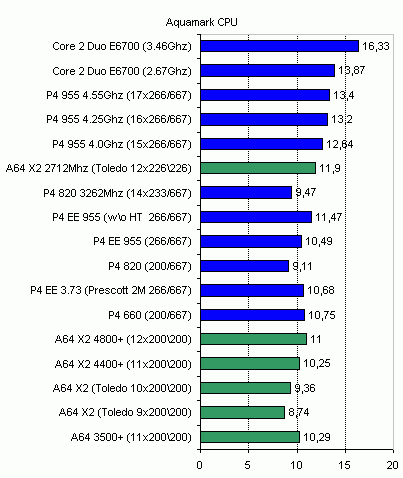 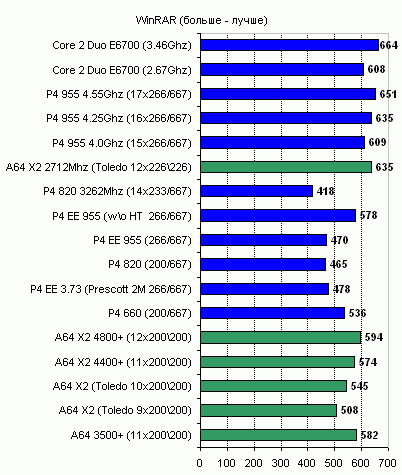 Kbit/s, the more - the better 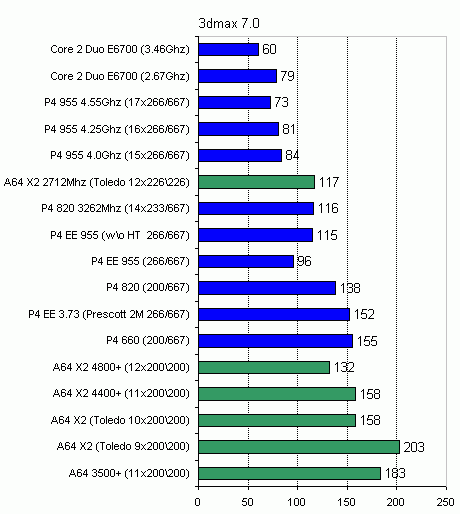 Kbit/s, the less - the better 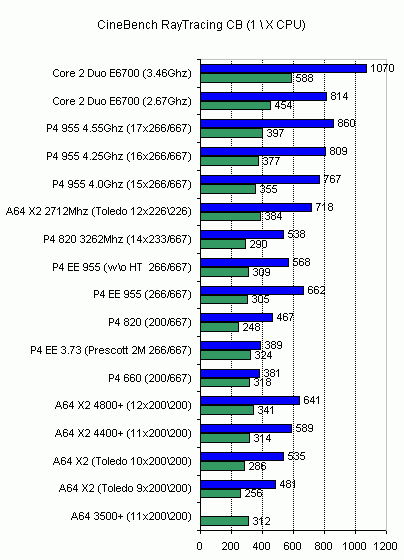 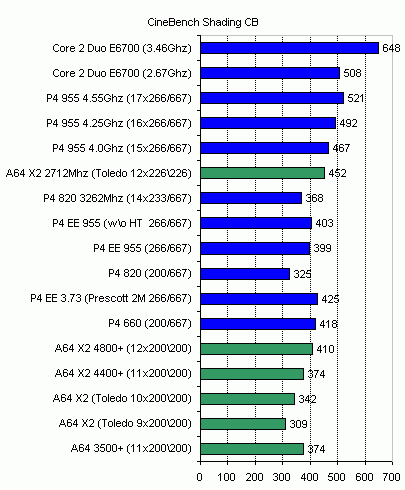 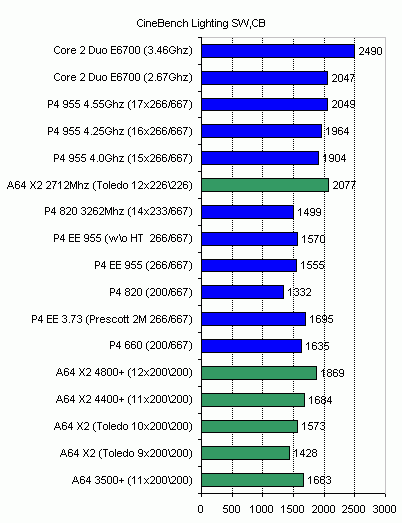  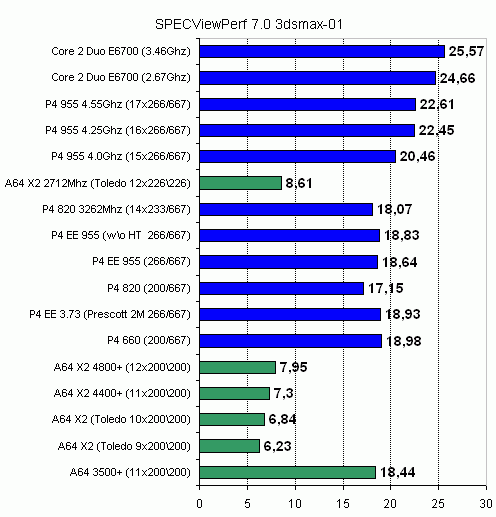 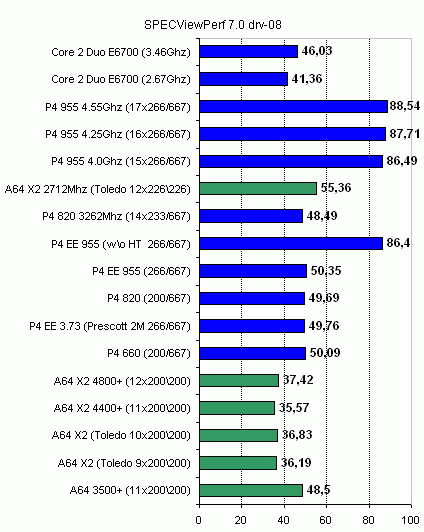 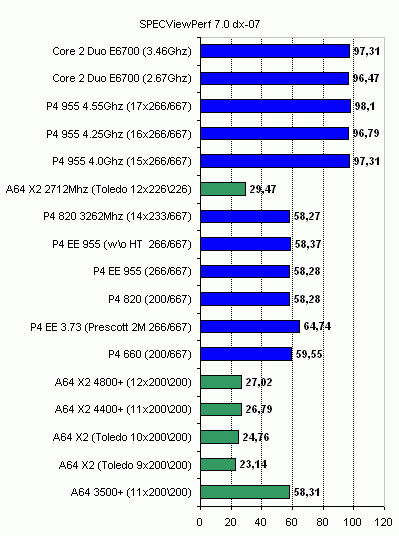 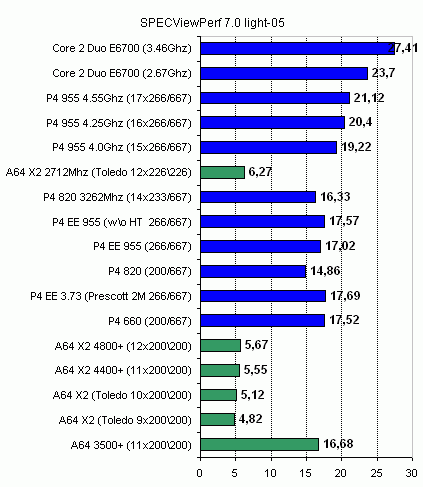 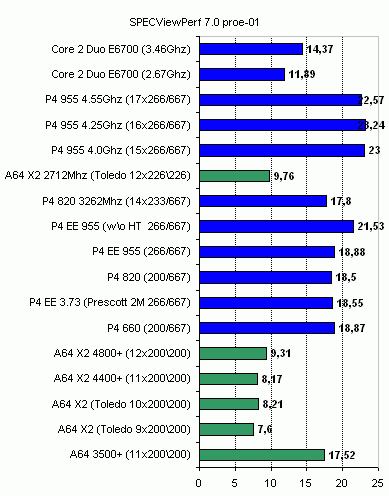 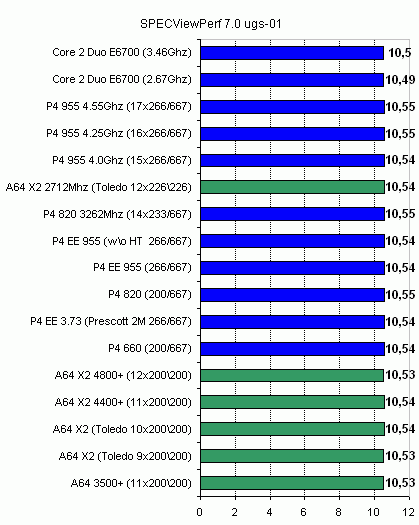 We included the results of overclocked processors into the list in order to estimate the scaling of performance as the clock speed goes up. Besides, our readers should see for themselves: what the target application will be for the processor being purchased. Final WordsIt would be an understatement to say that the Core 2 Duo processor demonstrates high performance. The operating speed is simply fantastic, by today's standards. At the same time, engineers at Intel were able to eliminate the major shortcoming of its processors - a lag in gaming applications. This is just where the performance of Conroe processors breaks all whatever records. For comparison, the CPU E6700 at 2.66 GHz overtakes the CPU Extreme Edition at 4.25-4.5 GHz in games! Also, at the nominal speed the CPU Conroe overtakes the overclocked Athlon X2 running at 2.7 GHz. Needless to say, if the Conroe is overclocked, its speed advantage becomes simply phenomenal. And the speed margin is indeed really high. In particular, with air-driven cooling we were able bringing the clock speed to 3.46 GHz. And that is with an engineering sample with stepping B1. Industrial processors with stepping B2 offers better overclocking potentials! So, what has been achieved as a result of the release of new Core 2 Duo processors? First, Intel has completely forgotten about any competition from AMD. AMD is hopelessly losing and even migration to DDR-2 will not help. Therefore, in the field of high-performance systems the user has only one choice - Core 2 Duo processors. All the previous Intel processors automatically become Celerons, including all the Extreme Edition CPUs priced at 1000 $. However, Intel can't ignore AMD completely for now. In particular, AMD has undertaken a vast price reduction, and the whole line of Athlon 3000+ - 3800+ processors now costs within 80$ to 140$. Intel's single-core CPUs cost more, and thrifty users have reasons to think of that. Certainly, Intel is also reducing prices for the previous generation of LGA775 processors. The lower-end Celeron can be made available at about $40, and the higher-end - at $65. Besides, Intel offers a really attractive dual-core Pentium 805 at $120-$130, and in this category it has no competitors (we should also take into account the serious overclocking capability of this model). It turns out that Intel is attacking over almost all the fronts, which may result in the reduction of AMD's market share. We should also note that sales of Intel processors solves a number of tasks. First, Intel discards its warehouse stocks and clears the shelves for a new generation of processors. Secondly, Intel is helping its partners get rid of a huge number of Conroe-incompatible motherboards. In conclusion, a pair of recommendations. First, it's better to migrate to the Core 2 Duo platform in early autumn of 2006. The assortment of processors will expand, and the prices will drop from speculative to the recommended. Secondly, the number of Conroe-compatible motherboards will essentially increase, and preliminary information on their overclocking capabilities will be compiled. Regarding the overclocking. In view of the high capability, there are possible difficulties in overclocking to FSN >= 500 MHz and we recommend to purchase a processor with as high multiplier as possible. The optimum combination "price/overclocking" belongs to the Core 2 Duo E6400 which now costs 225 $. But for the start of 2007 Intel has planned a release of the overclocker hit - the model E4300 with the multiplier = 9 and the 800 MHz bus. Therefore, the moment of release of this processor will become the time when the performance of new Core 2 Duo processors will be accessible to wide user audience.  P.S. Join the conference with all your questions, remarks and suggestions. |
|
|||||